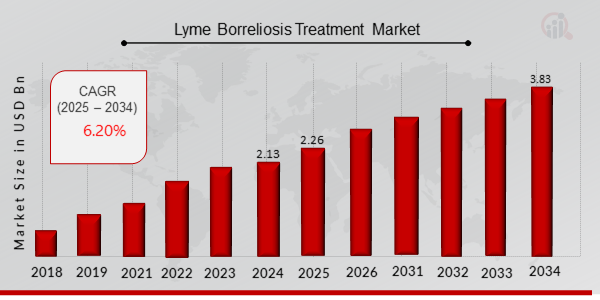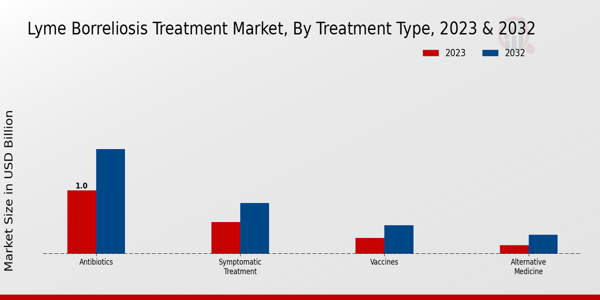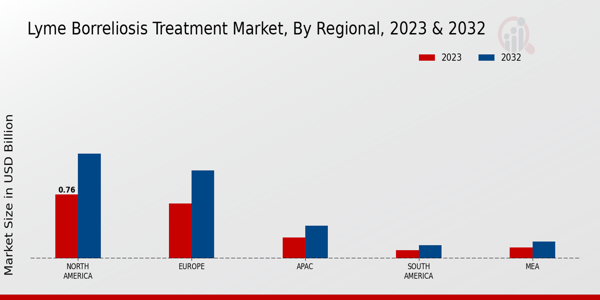Lyme Borreliosis Treatment Market Overview
As per MRFR analysis, the Lyme Borreliosis Treatment Market Size was estimated at 2.13 (USD Billion) in 2024. The Lyme Borreliosis Treatment Market Industry is expected to grow from 2.26 (USD Billion) in 2025 to 3.83 (USD Billion) till 2034, at a CAGR (growth rate) is expected to be around 6.02% during the forecast period (2025 - 2034).
Key Lyme Borreliosis Treatment Market Trends Highlighted
Various key drivers influence the Lyme Borreliosis Treatment Market. The rising incidence of Lyme disease, driven by climate change and changing geographical patterns of tick populations, significantly contributes to the demand for effective treatments. Increased awareness among healthcare professionals and the general public about Lyme disease allows for earlier diagnosis and treatment, further boosting market growth.
Additionally, ongoing research into novel therapeutics and the development of new antibiotic formulations provide rich opportunities for companies in this space, improving patient outcomes and reducing treatment costs.In recent times, there has been a noticeable focus on expanding treatment options for Lyme disease, with a shift toward personalized medicine.
This approach tailors’ treatments to individual patient needs, potentially enhancing efficacy. The use of combination therapies is also gaining traction, providing a multifaceted approach to managing the disease. Furthermore, advancements in diagnostic testing are enabling quicker and more accurate disease identification, promoting timely interventions. As awareness of the long-term effects of untreated Lyme disease grows, there is an increasing emphasis on post-treatment care and monitoring, creating new avenues for market expansion.The opportunities to be explored in the Lyme Borreliosis Treatment Market are vast.
With a progressive increase in funding for research and development, there is potential for innovative treatment options that address the nuances of Lyme disease and its co-infections. Developing educational initiatives and support networks for patients can enhance adherence to treatment plans, thereby improving overall health outcomes. The integration of technology in treatment management, including telemedicine and mobile health applications, further demonstrates the potential for better patient engagement and follow-up care. Together, these factors create a dynamic environment for growth and innovation in the treatment market for Lyme Borreliosis.

Source: Primary Research, Secondary Research, Market Research Future Database and Analyst Review
Lyme Borreliosis Treatment Market Drivers
Rising Incidence of Lyme Borreliosis
The increasing prevalence of Lyme borreliosis across various regions is a significant driver for the Lyme Borreliosis Treatment Market industry. As the number of reported cases rises, there is a growing demand for effective treatment options. Factors contributing to this increased incidence include changes in environmental conditions that favor the spread of ticks, which are the primary vectors for Lyme disease.
Additionally, urbanization and human encroachment into forested areas result in more frequent contact between humans and tick populations.This rising incidence compels healthcare systems to focus on developing new therapeutic strategies, ultimately driving investment in research and development for new drugs and treatment protocols within the Lyme Borreliosis Treatment Market. Moreover, heightened awareness among both healthcare providers and the general public regarding the symptoms and consequences of Lyme disease has led to earlier diagnosis and treatment.
The implementation of educational initiatives helps in reinforcing preventive measures and encourages patients to seek timely medical consultation, consequently increasing the demand for Lyme borreliosis treatments.Along with preventive actions, continuous surveillance of tick populations and the emergence of Lyme disease hotspots stimulate research initiatives to explore innovative treatment options within this sector, fostering overall growth within the Lyme Borreliosis Treatment Market industry.
Advancements in Medical Research and Drug Development
The Lyme Borreliosis Treatment Market industry is significantly bolstered by ongoing advancements in medical research and drug development. Technological improvements in biotechnology and pharmaceuticals are paving the way for the discovery of new drugs that can effectively combat Lyme disease. As researchers delve deeper into the complexities of the Borrelia bacteria, they are uncovering novel targets for therapeutic intervention.
The development of combination therapies, which may provide improved efficacy and reduced treatment duration, reflects the dynamic nature of drug development in response to the evolving patterns of Lyme borreliosis.Furthermore, enhanced understanding of the disease's pathophysiology enables the creation of targeted therapies that address not just symptom management but also long-term eradication of the infection.
Increasing Healthcare Expenditure
There has been a marked increase in healthcare expenditure across many regions, driven by the rising burden of various diseases, including Lyme borreliosis. Governments and private sectors are allocating more resources for disease management and treatment options. This financial commitment leads to improved availability of treatment facilities, access to medications, and support for ongoing research initiatives. The prioritization of public health against emerging and endemic diseases creates a favorable environment for growth in the Lyme Borreliosis Treatment Market industry, encouraging innovation and fostering competitive strategies among pharmaceutical companies.
Lyme Borreliosis Treatment Market Segment Insights
Lyme Borreliosis Treatment Market Treatment Type Insights
The Lyme Borreliosis Treatment Market has showcased notable progress in 2023, with a total market valuation of 1.89 USD Billion, underscoring a growing awareness and demand for effective treatment options. The Treatment Type segment plays a crucial role in shaping the landscape of this market, highlighting various approaches to managing Lyme borreliosis.
Among the different types, Antibiotics emerge as the leading choice, commanding a dominant share with a value of 1.0 USD Billion in 2023 and projected to grow to 1.65 USD Billion by 2032.This significant market holding indicates the essential role of antibiotics in combating Lyme disease, primarily due to their effectiveness in targeting the Borrelia bacteria responsible for the illness.
Symptomatic Treatment, valued at 0.5 USD Billion in 2023, also demonstrates a substantial presence within the market, expected to rise to 0.8 USD Billion by 2032, reflecting the need for supportive therapies that alleviate the varied symptoms faced by patients suffering from Lyme borreliosis. Although lesser in valuation, the Vaccines segment, currently at 0.25 USD Billion in 2023 and advancing to 0.45 USD Billion by 2032, positions itself as a significant opportunity area.The gradual uptake of vaccines signifies a potential shift in focus towards preventive measures, showcasing an essential trend in addressing the disease at its root.
Lastly, Alternative Medicine, accounting for 0.14 USD Billion in 2023 and projected to reach 0.3 USD Billion by 2032, highlights the increasing inclination towards holistic and non-conventional treatment modalities. This segment’s growth reflects patient preferences for complementary therapies that work alongside traditional treatments. Together, these insights into the Treatment Type segmentation of the Lyme Borreliosis Treatment Market underscore not only the prevailing strategies employed but also the nuances of patient care as therapeutic options evolve in response to the disease’s challenges.

Source: Primary Research, Secondary Research, Market Research Future Database and Analyst Review
Lyme Borreliosis Treatment Market Route of Administration Insights
The Lyme Borreliosis Treatment Market revenue for 2023 stands at 1.89 USD Billion and is on a growth trajectory, expected to reach 3.2 USD Billion by 2032. The Route of Administration segment plays a critical role in this market, reflecting diverse treatment methodologies. Oral administration remains a prevalent choice due to its convenience and ease of use, appealing to both patients and healthcare providers.
Intravenous treatments are often preferred for more severe cases, allowing faster drug delivery and enhanced efficacy, which positions it as a significant option within the market.Topical treatments, while perhaps less dominant, offer localized therapy that can address specific symptoms effectively, catering to those with milder manifestations of Lyme borreliosis. Each route of administration brings distinct benefits that align with patient needs and treatment outcomes, ultimately influencing overall market growth.
As the Lyme Borreliosis Treatment Market data suggests, embracing multiple routes enhances overall accessibility and patient adherence to treatment protocols, underpinning the market's evolving landscape.Current trends are pushing towards more innovative delivery methods, which promise to expand treatment capabilities and respond to the growing prevalence of Lyme disease.
Lyme Borreliosis Treatment Market Patient Type Insights
The Lyme Borreliosis Treatment Market, valued at 1.89 billion USD in 2023, demonstrates a robust segmentation based on patient type, including Pediatric, Adult, and Geriatric patients. Each patient category presents unique challenges and opportunities in treatment approaches. The significant prevalence of Lyme Borreliosis among pediatric patients necessitates tailored treatment options, as early intervention can greatly improve outcomes in younger populations, making this a crucial demographic.
Adult patients represent a substantial portion of the Lyme Borreliosis Treatment Market revenue, driven by lifestyle factors that increase exposure to ticks during outdoor activities.Meanwhile, the geriatric population often faces complications due to comorbidities, reinforcing the need for specialized care and treatment protocols. These insights into the Lyme Borreliosis Treatment Market statistics reveal that addressing the unique needs of each patient type is essential for market growth, as healthcare providers increasingly focus on personalized medicine. The ongoing trend toward developing innovative therapies also aligns with the growing awareness of Lyme disease, creating further opportunities in this evolving market landscape.
Lyme Borreliosis Treatment Market Distribution Channel Insights
The Lyme Borreliosis Treatment Market has seen remarkable valuation growth with a projected value of 1.89 billion USD in 2023. Within this market, the Distribution Channel plays a crucial role, encompassing Hospital Pharmacy, Retail Pharmacy, and Online Pharmacy. The Hospital Pharmacy segment is significant as it often serves patients with severe cases that require immediate and specialized medications, thus holding a pivotal position in the treatment process.
Retail Pharmacy remains a widely utilized channel, providing convenience for patients seeking over-the-counter solutions or prescriptions close to home.Furthermore, the Online Pharmacy sector is experiencing an upward trend, driven by the increasing adoption of e-commerce and patient preference for remote access to medications, especially in a post-pandemic world, suggesting a future shift towards digital platforms. The combination of these channels demonstrates the diversity and adaptability of the Lyme Borreliosis Treatment Market distribution strategies. Their respective dynamics contribute to a comprehensive market growth trajectory, supported by an increasing awareness of Lyme disease and demand for effective treatment options.
Lyme Borreliosis Treatment Market Regional Insights
The Lyme Borreliosis Treatment Market revenue is growing steadily across its regional segments, with North America holding the majority with a valuation of 0.76 USD Billion in 2023 and expected to reach 1.24 USD Billion by 2032. Europe follows as another significant player, valued at 0.65 USD Billion in 2023 and projected to grow to 1.04 USD Billion, reflecting strong public health initiatives in the region. The APAC region, valued at 0.25 USD Billion in 2023, is slowly emerging with growth potential reaching 0.39 USD Billion by 2032.
South America, despite being a smaller market with an initial value of 0.1 USD Billion, shows promise with growth to 0.16 USD Billion.Meanwhile, the MEA region stands at 0.13 USD Billion in 2023 with future projections reaching 0.2 USD Billion, indicating increasing awareness of Lyme disease and treatment options. North America’s market dominance is driven by advanced healthcare infrastructure, while Europe benefits from regulatory support for Lyme disease awareness. The overall market growth faces challenges, including the need for more widespread vaccination options and patient education, yet presents opportunities in expanding treatment solutions across underrepresented regions.

Source: Primary Research, Secondary Research, Market Research Future Database and Analyst Review
Lyme Borreliosis Treatment Market Key Players and Competitive Insights
The Lyme Borreliosis Treatment Market has witnessed significant developments in recent years, driven by the increasing prevalence of Lyme disease and heightened awareness among healthcare professionals and patients alike. This market is characterized by a variety of treatment modalities, including antibiotics, supportive therapies, and emerging innovative therapies that aim to improve patient outcomes. The competition within this market is intense, as multiple players strive to enhance their product offerings and expand their footprint. Various pharmaceutical companies are exploring advanced research, clinical trials, and partnerships to capture market share while addressing the distinct needs of patients suffering from Lyme borreliosis.
This landscape sets the stage for an engaging competitive environment where innovation and strategic positioning determine the leading players in the market.Merck and Co have emerged as a formidable entity in the Lyme Borreliosis Treatment Market, capitalizing on its strong research and development capabilities and established reputation in infectious diseases.
The company’s strengths lie in its robust pipeline of antibiotic therapies that target Lyme disease, offering effective treatment options to patients while adhering to international safety and compliance standards. Merck and Co also actively engage in collaborations and partnerships with research institutions and healthcare providers, allowing for cost-effective solutions and improved patient access to medications.
With a focus on advancing scientific understanding of Lyme borreliosis, the company continues to build its presence and influence in this space, enabling it to respond adeptly to changing regulatory environments and market dynamics.Pfizer holds a significant position in the Lyme Borreliosis Treatment Market, primarily attributed to its strong portfolio of antibiotic treatments proven effective against Lyme disease-causing bacteria. The company's commitment to research and development enables it to introduce new therapies that not only address current disease challenges but also adapt to emerging resistance patterns among pathogens.
Pfizer's established distribution channels and global reach ensure that its products are available to a wide range of healthcare settings, enhancing access for patients in various regions. Additionally, Pfizer’s emphasis on educational initiatives aimed at healthcare practitioners and communities promotes awareness about Lyme borreliosis, further supporting the importance of timely diagnosis and treatment. Through these efforts, Pfizer continues to solidify its influence and competitive edge in the market, while contributing to improved health outcomes for Lyme disease patients globally.
Key Companies in the Lyme Borreliosis Treatment Market Include
- Teva Pharmaceutical Industries
- Regeneron Pharmaceuticals
Lyme Borreliosis Treatment Market Industry Developments
Recent developments in the Lyme Borreliosis Treatment Market have highlighted an increasing focus on innovative therapies and drug development. Companies such as Merck & Co. and Pfizer are actively exploring new treatment modalities to address the complexities surrounding Lyme disease. The market is witnessing heightened activity, with significant research funding being allocated towards understanding the long-term effects of Lyme borreliosis, thereby creating avenues for the introduction of new therapeutics. Moreover, Amgen and Eli Lilly and Company are reportedly advancing their collaborative efforts to streamline the drug development process for Lyme disease treatment, indicating robust corporate partnerships.
In terms of mergers and acquisitions, there have been notable movements, particularly with companies like Novartis and Johnson & Johnson considering strategic acquisitions to diversify their portfolios in the infectious diseases space, aiming to bolster their presence in the Lyme treatment sector. The market valuation of these companies is projected to grow as they continue to expand their therapeutic options, ultimately impacting patient care and potentially improving treatment outcomes for Lyme borreliosis. This dynamic landscape showcases the continuous evolution of the treatment paradigm for Lyme disease within the pharmaceutical sector.
Lyme Borreliosis Treatment Market Segmentation Insights
Lyme Borreliosis Treatment Market Treatment Type Outlook
Lyme Borreliosis Treatment Market Route of Administration Outlook
Lyme Borreliosis Treatment Market Patient Type Outlook
Lyme Borreliosis Treatment Market Distribution Channel Outlook
Lyme Borreliosis Treatment Market Regional Outlook
| Report Attribute/Metric |
Details |
|
Market Size 2024
|
2.13 (USD Billion)
|
|
Market Size 2025
|
2.26 (USD Billion)
|
|
Market Size 2034
|
3.83 (USD Billion)
|
|
Compound Annual Growth Rate (CAGR)
|
6.02 % (2025 - 2034)
|
|
Report Coverage
|
Revenue Forecast, Competitive Landscape, Growth Factors, and Trends
|
|
Base Year
|
2024
|
|
Market Forecast Period
|
2025 - 2034
|
|
Historical Data
|
2020 - 2024
|
| Market Forecast Units |
USD Billion |
| Key Companies Profiled |
Merck and Co, Pfizer, Amgen, Mylan, Eli Lilly and Company, AbbVie, Teva Pharmaceutical Industries, GSK, Roche, Sandoz, AstraZeneca, Bayer, Novartis, Regeneron Pharmaceuticals, Johnson and Johnson |
| Segments Covered |
Treatment Type, Route of Administration, Patient Type, Distribution Channel, Regional |
| Key Market Opportunities |
Increasing awareness campaigns, Advancements in diagnostic technologies, Expansion of telemedicine services, Development of combination therapies, Rising prevalence of Lyme disease |
| Key Market Dynamics |
Increasing incidence of Lyme disease, Growing awareness and diagnosis, Advancements in treatment options, Rising demand for preventive measures, Expansion of healthcare infrastructure |
| Countries Covered |
North America, Europe, APAC, South America, MEA |
Frequently Asked Questions (FAQ):
The Lyme Borreliosis Treatment Market is expected to be valued at 3.2 USD Billion by 2034.
The anticipated CAGR for the Lyme Borreliosis Treatment Market from 2025 to 2034 is 6.0%.
North America is projected to hold the largest market share in the Lyme Borreliosis Treatment Market, valued at 1.24 USD Billion by 2034.
The market size of the Antibiotics segment is expected to reach 1.65 USD Billion by 2034.
The Symptomatic Treatment segment is valued at 0.5 USD Billion in 2023.
Major players in the Lyme Borreliosis Treatment Market include Merck and Co, Pfizer, Amgen, and Eli Lilly and Company.
The projected market value for the Vaccines segment is expected to be 0.45 USD Billion by 2034.
The APAC region is expected to be valued at 0.39 USD Billion in the Lyme Borreliosis Treatment Market by 2034.
The expected market size for Alternative Medicine treatments is projected to reach 0.3 USD Billion by 2034.
The Lyme Borreliosis Treatment Market faces challenges such as increasing competition and the need for innovative treatments.

















